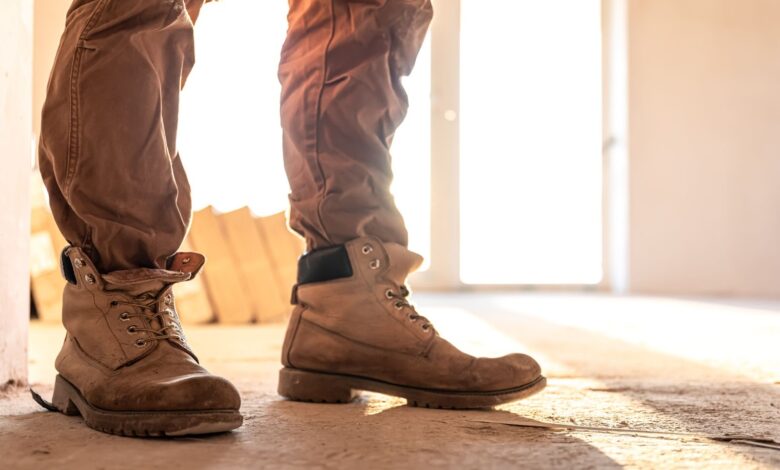8 Tips To Make Your Work Boots More Comfortable

Are your work boots giving you blisters, pinching your toes, or just plain uncomfortable? Whether you’re toiling on construction sites, braving the elements in rugged terrains, or simply on your feet all day, the agony of uncomfortable work boots can be unbearable. But don’t worry; we’ve got you covered.
In this article, we’ll share expert tips to help you transform those tough work boots into your most comfortable pair. From selecting the right size to proper maintenance, we’ll guide you through the steps you must take.
So, let’s dive in and make those boots work for you, not against you!
1. Choose the Right Insulation
When choosing the right insulated work boots, consider the temperature range you’ll be working in, the level of activity, and the potential exposure to wet conditions. Here are the insulation options you can consider:
- Thinsulate™: Lightweight, synthetic, and traps body heat without adding bulk.
- Primaloft®: Synthetic insulation, water-resistant, retains warmth even when wet.
- Felt: Traditional natural material offers good warmth in extreme cold.
- Shearling: Sheepskin insulation for warmth and comfort.
- Thermal Foam: Lightweight insulation for moderately cold weather.
- Neoprene: Synthetic rubber with excellent insulation and water resistance.
- Wool: Natural fiber for insulation and moisture-wicking.
- Aerogel: Lightweight and highly insulating, ideal for extreme cold.
Insulation is essential for cold weather; ensuring your boots are breathable and provide proper ventilation in warmer conditions is equally crucial. This prevents your feet from becoming sweaty and uncomfortable during long workdays.
2. Find the Right Size
Don’t underestimate the importance of choosing the right size to make your work boots more comfortable. It’s easy to think that a snug fit means better support, but that’s not always true. Work boots that are too tight can lead to discomfort, blisters, and even long-term foot problems.
Here’s a tip: Ensure enough room to move your toes freely when trying on boots. But also, ensure your heel isn’t sliding up and down as you walk. You should aim for a perfect balance between snug and spacious.
Remember, your feet tend to swell slightly during the day, so it’s advisable to try boots on in the afternoon. Getting the right size is a crucial step in enhancing boot comfort.
3. Break in the Boots Properly
You can’t expect instant comfort from your work boots right out of the box. They need time to conform to your foot shape and size. Start by wearing them around the house for a few days. Increase the wear time gradually, allowing your feet to adjust to the boots.
This process will soften the leather and reduce potential discomfort. If any areas of the boots feel too tight, consider using a shoe stretcher or applying a leather conditioner. While it might be tempting to speed up the process by wearing them for extended periods, resist the urge. This could lead to blisters or sore feet. Remember, a good break-in process equals comfy work boots.
4. Choose the Right Socks
Pairing the right socks with your new footwear enhances comfort and prevents blisters. The material of your socks plays a significant role. Opt for socks made from moisture-wicking fabrics like wool or synthetic blends to keep your feet dry and less prone to blisters.
Thickness is another factor to consider. Thin socks might not provide enough cushioning, causing friction between your foot and the boot. On the other hand, excessively thick socks could make your boots too tight, leading to discomfort. So, aim for a happy medium.
Finally, ensure your socks fit well. Loose socks can bunch up, causing pressure points, while tight socks can restrict circulation. So, spend time finding the right socks—it’s as important as choosing the perfect boots.
5. Use Quality Insoles
Insoles provide additional cushioning and support, transforming the feel of your work boots. They come in different materials, such as gel, foam, or leather. Each material offers unique benefits. For example, foam insoles are excellent at providing extra cushioning, while gel ones distribute weight evenly, reducing pressure points.
When choosing an insole, think about your specific needs and foot shape. Some insoles are designed for flat feet, while others are designed for high arches. Also, remember to replace them regularly. Like your socks, they wear out over time and lose effectiveness.
6. Maintain Your Boots
Taking care of your favorite pair of boots isn’t just about keeping them looking good; it’s also about ensuring they’re as comfortable as possible for as long as possible. Regular boot maintenance can significantly impact your foot’s comfort level, and it’s not as hard as you might think.
Here are four easy steps you can follow:
- Clean your boots regularly: Brush off dirt and debris, and wipe them down with a damp cloth. A clean boot is a happy boot!
- Apply a conditioner: Leather boots can dry out and become uncomfortable. Regular conditioning keeps them soft and flexible.
- Replace worn-out laces: Frayed or broken laces can cause discomfort. Keep a spare set handy.
- Store them properly: Don’t just kick them off at the end of the day. Store them upright and in a cool, dry place to maintain their shape.
7. Rotate Your Boots Regularly
Switching up your footwear regularly can extend the life and comfort of your boots. Don’t stick to the same pair day in and day out. Instead, maintain a rotation. This gives each pair a chance to air out and return to its original shape, reducing the risk of overuse and discomfort.
Imagine wearing the same shirt every day without washing it. Your boots need a break too! Not only does this strategy help them last longer, but it also keeps them fresh and comfortable for your feet.
8. Customize Boots to Fit Your Personal Needs
Everyone’s feet are different, and what works for one person might not work for another. Are you dealing with flat feet or high arches? Custom orthotic inserts can make a world of difference. They are designed to support your feet in the areas they need most, relieving pressure points and helping distribute weight evenly.
Maybe you need more cushioning in the heel, or perhaps you require a wider toe box. Don’t be afraid to experiment with different modifications until you find what works best. Customizing your boots to fit your needs can make your time on the job much more enjoyable and efficient.
Wrapping Up
Comfortable boots keep your feet happy and energized, enabling you to concentrate on your tasks, and leading to a more productive and efficient workflow. And now that you’ve got the tools to make your work boots comfier, you can have that positive work experience, too!
So, say goodbye to workday woes and step with comfort and confidence.
Good luck!



